Life Cycle Assessment of Innovative Carbon Dioxide Selective Membranes from Low Carbon Emission Sources: A Comparative Study
Abstract
1. Introduction
2. Methods
2.1. Goal and Scope
2.2. Processes Studied
2.3. System Boundary
2.4. Life Cycle Inventory
2.5. Impact Assessment
3. Results and Discussion
3.1. Life Cycle Assessment: Single-Stage Process
3.2. Life Cycle Assessment: Two-Stage Process
3.3. Life Cycle Assessment: Three-Stage Process
3.4. Comparison to Other Membrane Processes
3.5. Comparison to Other Separation Processes
3.6. Sensitivity Analysis ᷇
4. Conclusions
Supplementary Materials
Author Contributions
Funding
Institutional Review Board Statement
Data Availability Statement
Acknowledgments
Conflicts of Interest
References
- Hereher, M.E. Climate Change during the Third Millennium—The Gulf Cooperation Council Countries. Sustainability 2022, 14, 14181. [Google Scholar] [CrossRef]
- Monforte, I.; Evangelista, G.; Claps, P. Flooding Risk from Global Warming in Alpine Basins: An Estimate along a Stream Network. Environ. Sci. Proc. 2022, 21, 22. [Google Scholar]
- Fazzini, M.; Cordeschi, M.; Carabella, C.; Paglia, G.; Esposito, G.; Miccadei, E. Snow Avalanche Assessment in Mass Movement-Prone Areas: Results from Climate Extremization in Relationship with Environmental Risk Reduction in the Prati di Tivo Area (Gran Sasso Massif, Central Italy). Land 2021, 10, 1176. [Google Scholar] [CrossRef]
- Editorial Board. News. Mar. Pollut. Bull. 2020, 156, 111308. [Google Scholar] [CrossRef]
- Diaz, L.A.; Gao, N.; Adhikari, B.; Lister, T.E.; Dufek, E.J.; Wilson, A.D. Electrochemical production of syngas from CO2 captured in switchable polarity solvents. Green Chem. 2018, 20, 620–626. [Google Scholar] [CrossRef]
- Florides, G.A.; Christodoulides, P. Global warming and carbon dioxide through sciences. Environ. Int. 2009, 35, 390–401. [Google Scholar] [CrossRef]
- National Oceanic and Atmospheric Administration. Carbon Dioxide Now More than 50% Higher than Pre-Industrial Levels. Available online: https://www.noaa.gov/news-release/carbon-dioxide-now-more-than-50-higher-than-pre-industrial-levels (accessed on 16 January 2023).
- U.S. Environmental Protection Agency. Global Greenhouse Gas Emissions Data. Available online: https://www.epa.gov/ghgemissions/global-greenhouse-gas-emissions-data (accessed on 16 January 2023).
- Althor, G.; Watson, J.E.M.; Fuller, R.A. Global mismatch between greenhouse gas emissions and the burden of climate change. Sci. Rep. 2016, 6, 20281. [Google Scholar] [CrossRef]
- Adhikari, B.; Chowdhury, N.A.; Diaz, L.A.; Jin, H.; Saha, A.K.; Shi, M.; Klaehn, J.R.; Lister, T.E. Electrochemical leaching of critical materials from lithium-ion batteries: A comparative life cycle assessment. Resour. Conserv. Recycl. 2023, 193, 106973. [Google Scholar] [CrossRef]
- Chen, Y.; Li, X.; Hua, H.; Lund, P.D.; Wang, J. Exergo-environmental cost optimization of a solar-based cooling and heating system considering equivalent emissions of life-cycle chain. Energy Convers. Manag. 2022, 258, 115534. [Google Scholar] [CrossRef]
- Marocco, P.; Gandiglio, M.; Audisio, D.; Santarelli, M. Assessment of the role of hydrogen to produce high-temperature heat in the steel industry. J. Clean. Prod. 2023, 388, 135969. [Google Scholar] [CrossRef]
- Zhang, X.; Zhang, G.; Song, C.; Guo, X. Catalytic Conversion of Carbon Dioxide to Methanol: Current Status and Future Perspective. Front. Energy Res. 2021, 8, 621119. [Google Scholar] [CrossRef]
- Dowson, G.R.M.; Styring, P. Demonstration of CO2 Conversion to Synthetic Transport Fuel at Flue Gas Concentrations. Front. Energy Res. 2017, 5, 26. [Google Scholar] [CrossRef]
- Zevenhoven, R.; Fagerlund, J. 16—Mineralisation of carbon dioxide (CO2). In Developments and Innovation in Carbon Dioxide (CO2) Capture and Storage Technology; Maroto-Valer, M.M., Ed.; Woodhead Publishing: Sawston, UK, 2010; Volume 2, pp. 433–462. [Google Scholar]
- Naraharisetti, P.K.; Yeo, T.Y.; Bu, J. New classification of CO2 mineralization processes and economic evaluation. Renew. Sustain. Energy Rev. 2019, 99, 220–233. [Google Scholar] [CrossRef]
- Núñez-López, V.; Moskal, E. Potential of CO2-EOR for Near-Term Decarbonization. Front. Clim. 2019, 1, 5. [Google Scholar] [CrossRef]
- Perera, M.S.A.; Gamage, R.P.; Rathnaweera, T.D.; Ranathunga, A.S.; Koay, A.; Choi, X. A Review of CO2-Enhanced Oil Recovery with a Simulated Sensitivity Analysis. Energies 2016, 9, 481. [Google Scholar] [CrossRef]
- Folger, P.F. Carbon Capture and Sequestration (CCS) in the United States; Congressional Research Service 2017. In Carbon Capture and Sequestration (CCS) in the United States; Congressional Research Service: Washington, DC, USA, 2017. [Google Scholar]
- Cui, Z.; deMontigny, D. Part 7: A review of CO2capture using hollow fiber membrane contactors. Carbon Manag. 2014, 4, 69–89. [Google Scholar] [CrossRef]
- Oko, E.; Wang, M.; Joel, A.S. Current status and future development of solvent-based carbon capture. Int. J. Coal Sci. Technol. 2017, 4, 5–14. [Google Scholar] [CrossRef]
- Heldebrant, D.J.; Kothandaraman, J.; Mac Dowell, N.; Brickett, L. Next steps for solvent-based CO2 capture; integration of capture, conversion, and mineralisation. Chem. Sci. 2022, 13, 6445–6456. [Google Scholar] [CrossRef]
- Siqueira, R.M.; Freitas, G.R.; Peixoto, H.R.; Nascimento, J.F.d.; Musse, A.P.S.; Torres, A.E.B.; Azevedo, D.C.S.; Bastos-Neto, M. Carbon Dioxide Capture by Pressure Swing Adsorption. Energy Procedia 2017, 114, 2182–2192. [Google Scholar] [CrossRef]
- Font-Palma, C.; Cann, D.; Udemu, C. Review of Cryogenic Carbon Capture Innovations and Their Potential Applications. C 2021, 7, 58. [Google Scholar] [CrossRef]
- Song, C.; Liu, Q.; Deng, S.; Li, H.; Kitamura, Y. Cryogenic-based CO2 capture technologies: State-of-the-art developments and current challenges. Renew. Sustain. Energy Rev. 2019, 101, 265–278. [Google Scholar] [CrossRef]
- Machida, H.; Hashiride, R.; Niinomi, R.; Yanase, K.; Hirayama, M.; Umeda, Y.; Norinaga, K. An Alternative CO2 Capture with a Pressure Swing Amine Process Driven by Cryogenic Pumping with the Unused Cold Energy of Liquefied Natural Gas. ACS Sustain. Chem. Eng. 2021, 9, 15908–15914. [Google Scholar] [CrossRef]
- Giordano, L.; Roizard, D.; Favre, E. Life cycle assessment of post-combustion CO2 capture: A comparison between membrane separation and chemical absorption processes. Int. J. Greenh. Gas Control 2018, 68, 146–163. [Google Scholar] [CrossRef]
- Stewart, F.F.; Orme, C.J.; Klaehn, J.R.; Adhikari, B.; Shenderova, O.A.; Nunn, N.A.; Torelli, M.D.; McGuire, G.E.; Lee, T.H.; Balachandran, U. Mixed Matrix Membranes, and related gas separation membrane apparatuses, gaseous fluid treatment Systems, and Methods. U.S. Patent Application 17/174,796, 12 August 2021. [Google Scholar]
- Pellegrino, J.J.; Nassimbene, R.; Noble, R.D. Facilitated transport of CO2 through highly swollen ion-exchange membranes: The effect of hot glycerine pretreatment. Gas Sep. Purif. 1988, 2, 126–130. [Google Scholar] [CrossRef]
- Khalilpour, R.; Mumford, K.; Zhai, H.; Abbas, A.; Stevens, G.; Rubin, E.S. Membrane-based carbon capture from flue gas: A review. J. Clean. Prod. 2015, 103, 286–300. [Google Scholar] [CrossRef]
- Adhikari, B.; Orme, C.J.; Jones, M.G.; Wendt, D.S.; Mines, G.L.; Wilson, A.D. Diffusion membrane generation of 1-cyclohexylpiperidinium bicarbonate. J. Membr. Sci. 2019, 583, 258–266. [Google Scholar] [CrossRef]
- Pellegrino, J.J.; Giarratano, P. Ion-exchange membranes for bulk separation of H2S and CO2. In Proceedings of the US Department of Energy Contractors Review Meeting on Fuel Cells, Morgantown, WV, USA, 14–15 July 1992. [Google Scholar]
- Mores, P.L.; Arias, A.M.; Scenna, N.J.; Mussati, M.C.; Mussati, S.F. Cost-based comparison of multi-stage membrane configurations for carbon capture from flue gas of power plants. Int. J. Greenh. Gas Control 2019, 86, 177–190. [Google Scholar] [CrossRef]
- Zhao, L.; Menzer, R.; Riensche, E.; Blum, L.; Stolten, D. Concepts and investment cost analyses of multi-stage membrane systems used in post-combustion processes. Energy Procedia 2009, 1, 269–278. [Google Scholar] [CrossRef]
- Yeo, Z.Y.; Chew, T.L.; Zhu, P.W.; Mohamed, A.R.; Chai, S.-P. Conventional processes and membrane technology for carbon dioxide removal from natural gas: A review. J. Nat. Gas Chem. 2012, 21, 282–298. [Google Scholar] [CrossRef]
- Tong, Z.; Ho, W.S.W. Facilitated transport membranes for CO2 separation and capture. Sep. Sci. Technol. 2017, 52, 156–167. [Google Scholar] [CrossRef]
- Ozkan, M.; Nayak, S.P.; Ruiz, A.D.; Jiang, W. Current status and pillars of direct air capture technologies. iScience 2022, 25, 103990. [Google Scholar] [CrossRef]
- Sabatino, F.; Grimm, A.; Gallucci, F.; van Sint Annaland, M.; Kramer, G.J.; Gazzani, M. A comparative energy and costs assessment and optimization for direct air capture technologies. Joule 2021, 5, 2047–2076. [Google Scholar] [CrossRef]
- Fujikawa, S.; Selyanchyn, R.; Kunitake, T. A new strategy for membrane-based direct air capture. Polym. J. 2021, 53, 111–119. [Google Scholar] [CrossRef]
- Fennell, P.; Driver, J.; Bataille, C.; Davis, S. Cement and steel—nine steps to net zero. Nature 2022, 603, 574–577. [Google Scholar] [CrossRef]
- Lee, J.W.; Ahn, H.; Kim, S.; Kang, Y.T. Low-concentration CO2 capture system with liquid-like adsorbent based on monoethanolamine for low energy consumption. J. Clean Prod. 2023, 390, 136141. [Google Scholar] [CrossRef]
- Adhikari, B.; Jones, M.G.; Orme, C.J.; Wendt, D.S.; Wilson, A.D. Compatibility study of nanofiltration and reverse osmosis membranes with 1-cyclohexylpiperidenium bicarbonate solutions. J. Membr. Sci. 2017, 527, 228–235. [Google Scholar] [CrossRef]
- Wilson, A.D.; Wendt, D.S.; Orme, C.J.; Adhikari, B.; Ginosar, D.M. Methods and Systems for Treating an Aqueous Solution. U.S. Patent 11,261,111, 1 March 2022. [Google Scholar]
- Stewart, F.F.; Harrup, M.K.; Orme, C.J.; Luther, T.A. Phosphazene membranes for gas separations. U.S. Patent 7,074,256 B2, 11 July 2006. [Google Scholar]
- Wilson, A.D.; Orme, C.J.; Klaehn, J.R.; Adhikari, B.; Stewart, F.F.; Snyder, S.W. Methods, Systems, and Apparatuses for Treating Fluids Using Thermal Gradient Osmosis. U.S. Patent Application 17/009,360, 4 March 2021. [Google Scholar]
- Wilson, A.D.; Wendt, D.S.; Orme, C.J.; Mines, G.L.; Jones, M.G.; Adhikari, B. Methods and Systems for Treating a Switchable Polarity Material, and Related Methods of Liquid Treatment. U.S. Patent 10,195,543, 5 February 2019. [Google Scholar]
- Ghasemzadeh, K.; Tilebon, S.M.S.; Basile, A. Chapter 5—Membrane technologies for exhaust gas cleaning and carbon capture and sequestration. In Current Trends and Future Developments on (Bio-) Membranes; Basile, A., Spazzafumo, G., Eds.; Elsevier: Amsterdam, The Netherlands, 2020; pp. 97–123. [Google Scholar]
- Orme, C.J.; McNally, J.S.; Klaehn, J.R.; Stewart, F.F. Mixed substituent ether-containing polyphosphazene/poly(bis-phenoxyphosphazene) blends as membranes for CO2 separation from N-2. J. Appl. Polym. Sci. 2021, 138, 50207. [Google Scholar] [CrossRef]
- Kusuma, V.A.; McNally, J.S.; Baker, J.S.; Tong, Z.; Zhu, L.X.; Orme, C.J.; Stewart, F.F.; Hopkinson, D.P. Cross-Linked Polyphosphazene Blends as Robust CO2 Separation Membranes. ACS Appl. Mater. Interfaces 2020, 12, 30787–30795. [Google Scholar] [CrossRef]
- Orme, C.J.; Klaehn, J.R.; Harrup, M.K.; Luther, T.A.; Peterson, E.S.; Stewart, F.F. Gas permeability in rubbery polyphosphazene membranes. J. Membr. Sci. 2006, 280, 175–184. [Google Scholar] [CrossRef]
- Orme, C.J.; Stewart, F.F. Mixed gas hydrogen sulfide permeability and separation using supported polyphosphazene membranes. J. Membr. Sci. 2005, 253, 243–249. [Google Scholar] [CrossRef]
- Luther, T.A.; Stewart, F.F.; Budzien, J.L.; LaViolette, R.A.; Bauer, W.F.; Harrup, M.K.; Allen, C.W.; Elayan, A. On the mechanism of ion transport through polyphosphazene solid polymer electrolytes: NMR, IR, and Raman spectroscopic studies and computational analysis of N-15-labeled polyphosphazenes. J. Phys. Chem. B 2003, 107, 3168–3176. [Google Scholar] [CrossRef]
- Orme, C.J.; Harrup, M.K.; McCoy, J.D.; Weinkauf, D.H.; Stewart, F.F. Pervaporation of water-dye, alcohol-dye, and water-alcohol mixtures using a polyphosphazene membrane. J. Membr. Sci. 2002, 197, 89–101. [Google Scholar] [CrossRef]
- Stewart, F.F.; Orme, C.J.; Harrup, M.K.; Lash, R.P.; Weinkauf, D.H.; McCoy, J.D. Membrane separations using functionalized polyphosphazene materials. Abstr. Pap. Am. Chem. S 2001, 222, U393. [Google Scholar]
- Orme, C.J.; Harrup, M.K.; Luther, T.A.; Lash, R.P.; Houston, K.S.; Weinkauf, D.H.; Stewart, F.F. Characterization of gas transport in selected rubbery amorphous polyphosphazene membranes. J. Membr. Sci. 2001, 186, 249–256. [Google Scholar] [CrossRef]
- Lister, T.E.; Dufek, E.J.; Wilson, A.D.; Aldana, L.A.D.; Adhikari, B.; Gao, N. Methods and Systems for the Electrochemical Reduction of Carbon Dioxide Using Switchable Polarity Materials. U.S. Patent 10,975,477, 13 April 2021. [Google Scholar]
- Klaehn, J.R.; Orme, C.J.; Wilson, A.D.; Adhikari, B.; Stewart, F.F.; Snyder, S.W. Thermally Reflective Membrane Apparatuses, and Related Fluid Treatment Systems and Methods. U.S. Patent Application 17/009,421, 4 March 2021. [Google Scholar]
- Wendt, L.M.; Wahlen, B.D.; Adhikari, B. Methods of Producing Succinic Acid from a Biomass. U.S. Patent Application 17/652,835, 1 September 2022. [Google Scholar]
- Sekizkardes, A.K.; Budhathoki, S.; Zhu, L.; Kusuma, V.; Tong, Z.; McNally, J.S.; Steckel, J.A.; Yi, S.; Hopkinson, D. Molecular design and fabrication of PIM-1/polyphosphazene blend membranes with high performance for CO2/N2 separation. J. Membr. Sci. 2021, 640, 119764. [Google Scholar] [CrossRef]
- Ge, Z.; Li, Q.; Wang, Y. Free Energy Calculation of Nanodiamond-Membrane Association—The Effect of Shape and Surface Functionalization. J. Chem. Theory Comput. 2014, 10, 2751–2758. [Google Scholar] [CrossRef]
- Adhikari, B.; Orme, C.J.; Klaehn, J.R. Techno-economic analysis of carbon dioxide enrichment from low carbon sources using membranes. J. Clean. Prod. 2023, 36, 35. [Google Scholar]
- Ayres, R.U. Life cycle analysis: A critique. Resour. Conserv. Recycl. 1995, 14, 199–223. [Google Scholar] [CrossRef]
- Wang, M.Q. GREET 1.0—Transportation Fuel Cycles Model: Methodology and Use; Argonne National Lab.(ANL): Argonne, IL, USA, 1996. [Google Scholar]
- Sutar, D.D.; Jadhav, S.V. Life cycle assessment of methanol production by natural gas route. Mater. Today Proc. 2022, 57, 1559–1566. [Google Scholar] [CrossRef]
- Rebitzer, G.; Ekvall, T.; Frischknecht, R.; Hunkeler, D.; Norris, G.; Rydberg, T.; Schmidt, W.P.; Suh, S.; Weidema, B.P.; Pennington, D.W. Life cycle assessment: Part 1: Framework, goal and scope definition, inventory analysis, and applications. Environ. Int. 2004, 30, 701–720. [Google Scholar] [CrossRef]
- Adhikari, B.; Lister, T.E.; Reddy, R.G. Techno-economic and life cycle assessment of aluminum electrorefining from mixed scraps using ionic liquid. Sustain. Prod. Consum. 2022, 33, 932–941. [Google Scholar] [CrossRef]
- Neupane, G.; Adhikari, B.; Wiggins, A. Assessment of Economic Impact of Permitting Timelines on Produced Geothermal Power in Imperial County, California. In Proceedings of the Workshop on Geothermal Reservoir Engineering, Stanford, CA, USA, 7 February 2022–9 February 2022; p. Medium: ED. [Google Scholar]
- Adhikari, B.; Orme, C.J.; Klaehn, J.R.; Stewart, F.F. Technoeconomic analysis of oxygen-nitrogen separation for oxygen enrichment using membranes. Sep. Purif. Technol. 2021, 268, 118703. [Google Scholar] [CrossRef]
- Wendt, D.; Adhikari, B.; Orme, C.; Wilson, A. Produced water treatment using the switchable polarity solvent forward osmosis (SPS FO) desalination process: Preliminary engineering design basis. In Proceedings of the Geothermal Resources Council Annual Meeting, Sacramento, CA, USA, 23–26 October 2016. [Google Scholar]
- Adhikari, B.; Pellegrino, J. Life-cycle assessment of five microalgae-to-biofuels processes of varying complexity. J. Renew. Sustain. Energy 2015, 7, 043136. [Google Scholar] [CrossRef]
- Adhikari, B.; Pellegrino, J. Separation Challenges and Optimizations of Sustainable Algal and Lignocellulose Based Biofuels; University of Colorado Boulder: Boulder, CO, USA, 2015. [Google Scholar]
- Amer, L.; Adhikari, B.; Pellegrino, J. Technoeconomic analysis of five microalgae-to-biofuels processes of varying complexity. Bioresour. Technol. 2011, 102, 9350–9359. [Google Scholar] [CrossRef] [PubMed]
- Diaz, L.A.; Strauss, M.L.; Adhikari, B.; Klaehn, J.R.; McNally, J.S.; Lister, T.E. Electrochemical-assisted leaching of active materials from lithium ion batteries. Resour. Conserv. Recycl. 2020, 161, 104900. [Google Scholar] [CrossRef]
- Diaz, L.A.; Strauss, M.L.; Adhikari, B.; Klaehn, J.R.; McNally, J.S.; Lister, T.E. Electrochemical-assisted leaching of active materials from lithium ion batteries. Resour. Conserv. Recycl. 2021, 175, 105857. [Google Scholar] [CrossRef]
- Khoo, H.H.; Tan, R.B.H. Life Cycle Investigation of CO2 Recovery and Sequestration. Environ. Sci. Technol. 2006, 40, 4016–4024. [Google Scholar] [CrossRef]
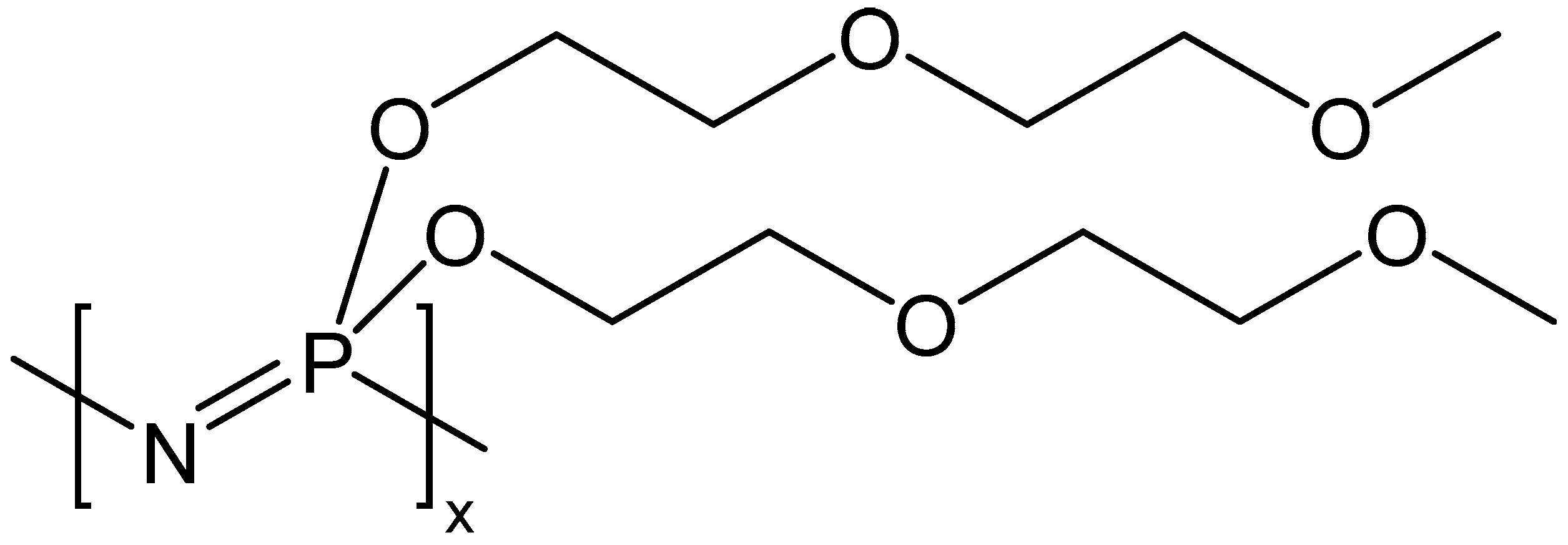
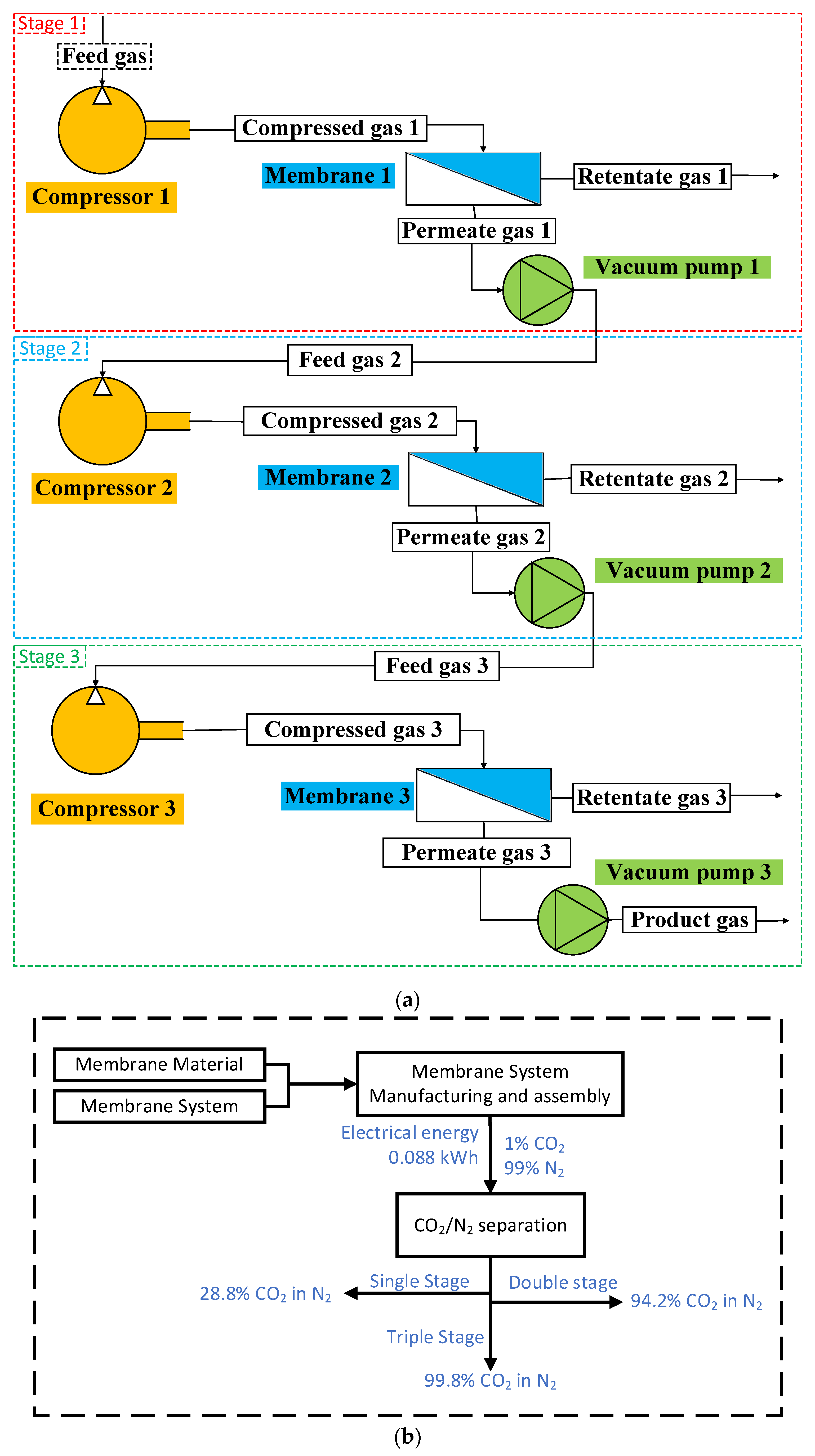
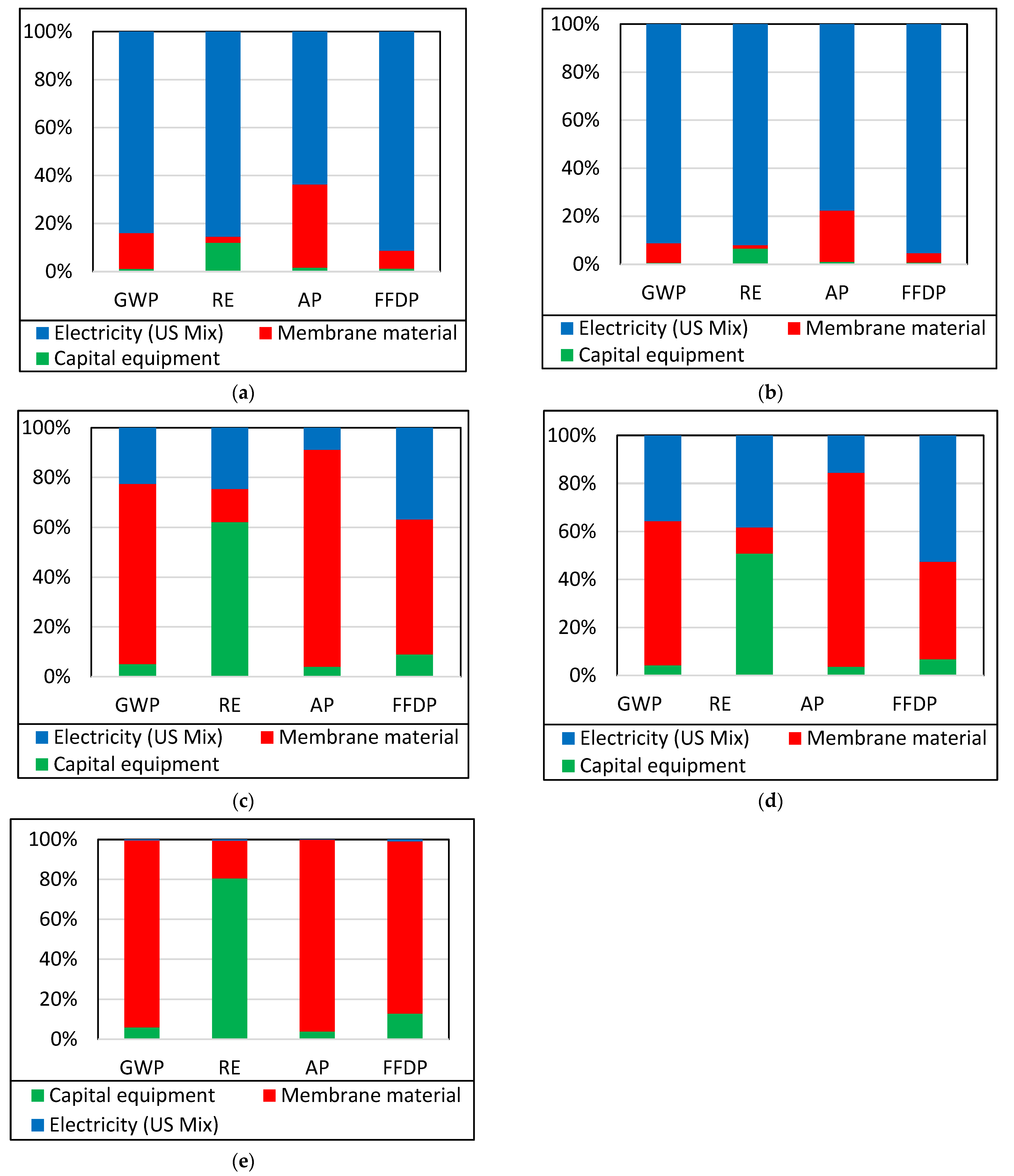
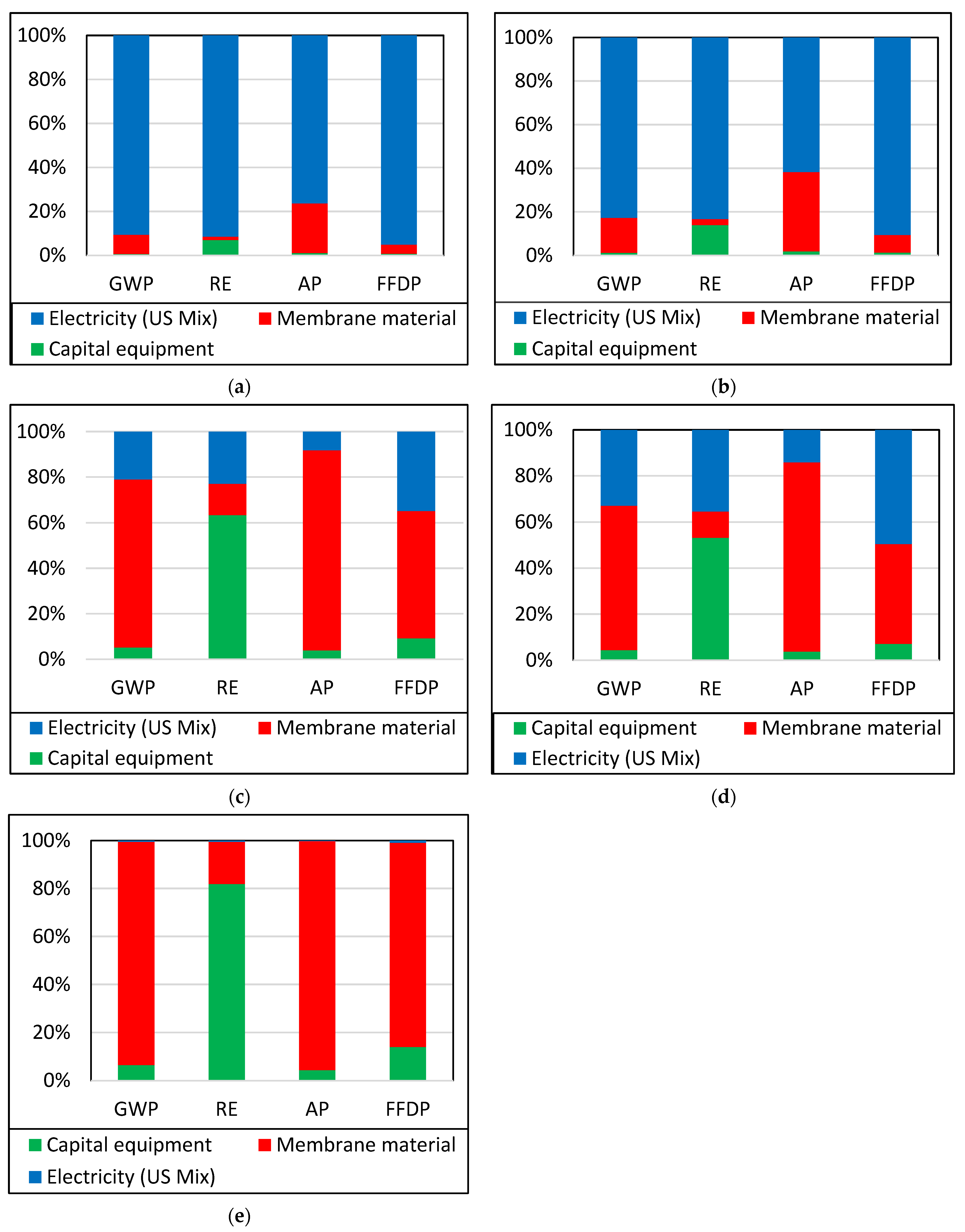
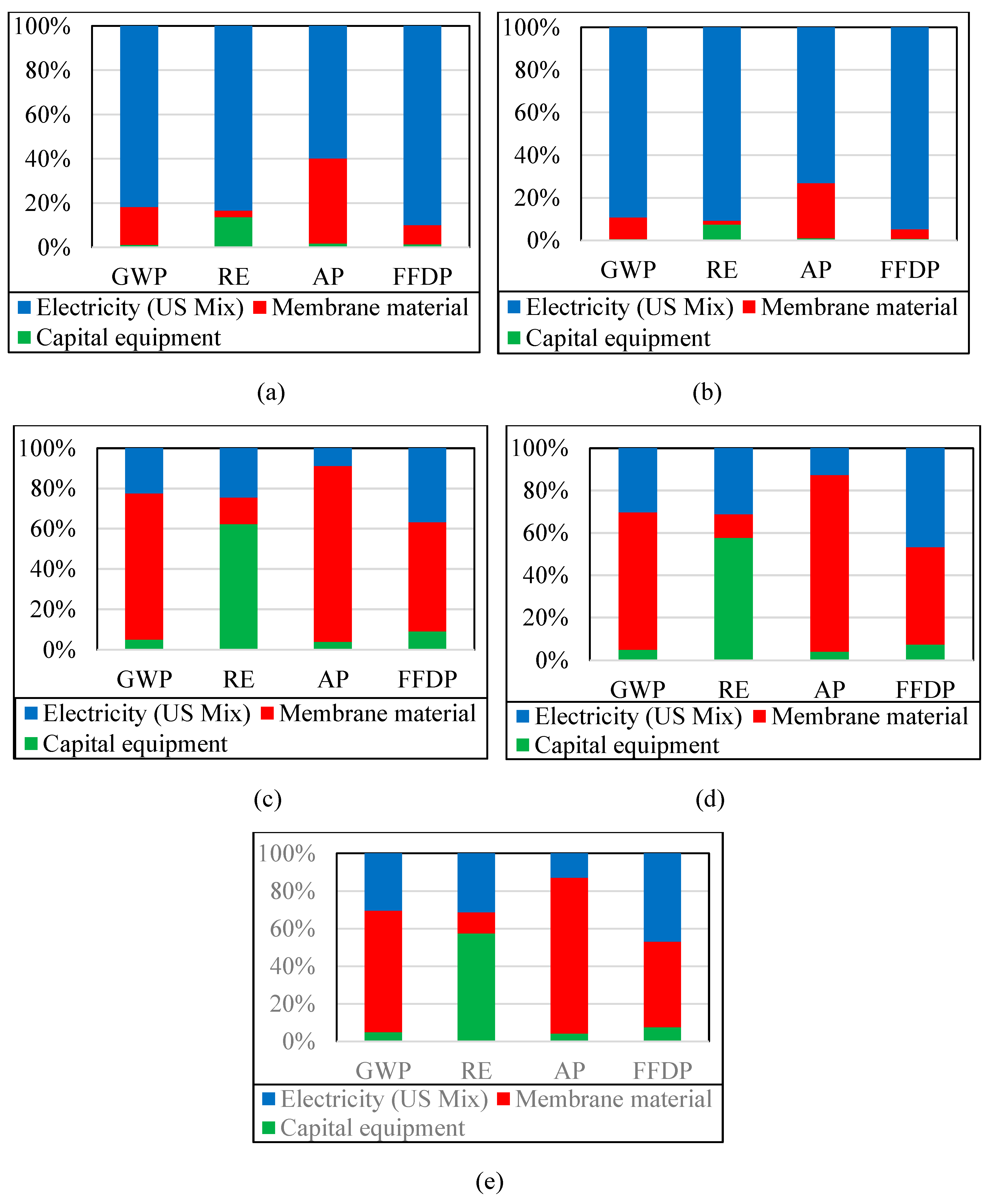
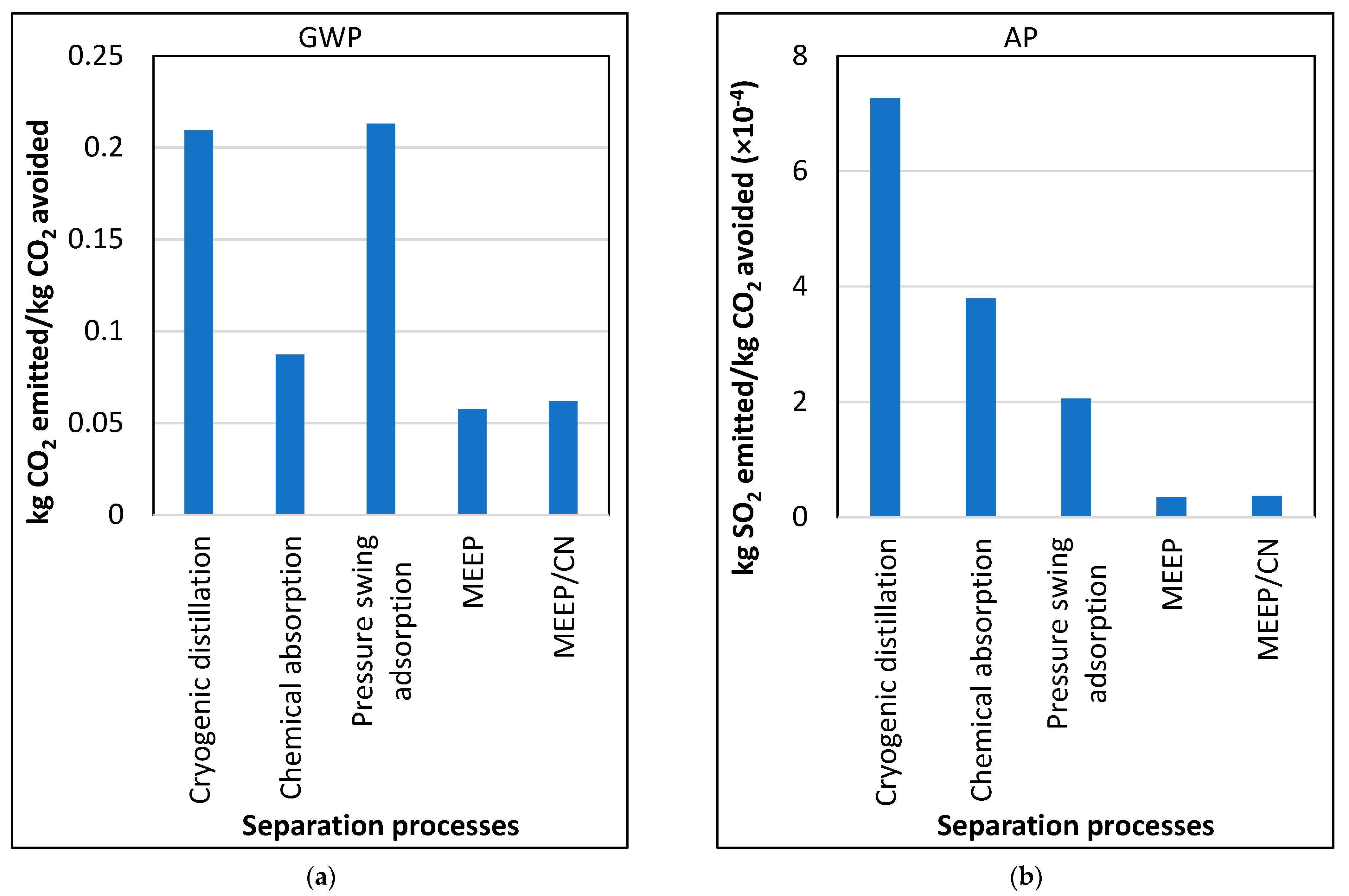

| Membrane | Membrane Thickness (µm) | Feed Gas (CO2 vol%/N2 vol%) | Separation Condition (Temperature °C/Pressure Bar) | Permeability (Barrer) | CO2/N2 Selectivity |
|---|---|---|---|---|---|
| Pebax LE | 1 | pure gas | 25/1 | 55.0 | 40.0 |
| Pebax HE | 1 | pure gas | 25/1 | 100.0 | 70.0 |
| Pebax/ZIF-8 | 105 | pure gas | 23/1 | 105.0 | 34.8 |
| Pebax/ZIF-8(90 nm) | 55 | pure gas | 25/1 | 154.0 | 40.5 |
| Pebax/ZIF-8–90(50) | 75 | pure gas | 35/-- | 217.5 | 54.1 |
| Pebax/NH2-ZIF-8 | - | pure gas | 25/1 | 163.8 | 62.0 |
| Pebax/UiO-66 | 18 | 50/50 | 25/3 | 97.2 | 56.6 |
| Pebax/NH2-MIL-53 | 75 | pure gas | 35/10 | 120.0 | 55.5 |
| Pebax/MoS2 nanosheet | 28 | pure gas | 30/1 | 52.3 | 90.6 |
| Pebax/NaY | 23 | pure gas | 30/2 | 82.8 | 35.0 |
| Pebax/NOTT300 | 38 | pure gas | 25/10 | 395.2 | 61.2 |
| Pebax/MCM-41 | 88 | pure gas | 25/2 | 122.5 | 53.0 |
| Pebax/GO | 83 | 20/80 | 35/2 | 105.0 | 41.2 |
| Pebax/aminosilane-GO | 83 | 20/80 | 35/2 | 166.3 | 45.2 |
| Pebax/PEI-ZIF-8 | 1 | 50/50 | 25/1 | 13.0 | 49.0 |
| MEEP | 0.1 | 99/1 | 15/1 | 100.0 | 40.0 |
| MEEP/CND | 0.1 | 99/1 | 15/1 | 100.0 | 35.0 |
| Input Parameters | CO2 (kg) | CH4 (g) | N2O (g) | PM2.5 (mg) | SO2 (g) | Fossil Fuel Depletion (MJ) |
|---|---|---|---|---|---|---|
| US Mix (electricity) | 0.390 | 0.854 | 0.008 | 24.5 | 0.247 | 5.46 |
| Capital equipment | 0.792 | 1.88 | 0.017 | 563.1 | 0.997 | 12 |
| Membrane material | 1.55 | 21.4 | 33.6 | 120.8 | 22.1 | 73 |
| Impact Category | Global Warming | Respiratory Effects | Acidification Potential | Fossil Fuel Depletion |
|---|---|---|---|---|
| Unit | kg CO2 eq/kg CO2 avoided | kg PM2.5 eq/kg CO2 avoided | kg SO2 eq/kg CO2 avoided | MJ surplus/kg CO2 avoided |
| MEEP only | 4.40 × 10−2 | 5.22 × 10−6 | 5.70 × 10−5 | 0.566 |
| MEEP/CN | 4.42 × 10−2 | 5.48 × 10−6 | 5.55 × 10−5 | 0.592 |
| Pebax LE | 0.163 | 1.15 × 10−5 | 2.69 × 10−4 | 1.35 |
| Pebax HE | 7.53 × 10−2 | 6.10 × 10−6 | 1.19 × 10−4 | 0.698 |
| Pebax/ZIF-8 | 8.42 | 4.18 × 10−4 | 1.5 × 10−2 | 55.3 |
| Pebax/ZIF-8 (90 nm) | 2.49 | 1.35 × 10−4 | 4.42 × 10−4 | 1.66 |
| Pebax/ZIF-9 90 (50) | 1.98 | 1.07 × 10−4 | 3.51 × 10−3 | 13.2 |
| Pebax/NH2-ZIF-8 | 6.04 × 10−2 | 5.45 × 10−6 | 9.12 × 10−5 | 0.613 |
| Pebax/UiO-66 | 1.04 | 5.77 × 10−5 | 1.85 × 10−3 | 7.1 |
| Pebax/NH2-MIL-53 | 3.5 | 1.88 × 10−4 | 6.23 × 10−3 | 23.2 |
| Pebax/MoS2 nanosheet | 2.26 | 1.21 × 10−4 | 4.01 × 10−3 | 15.0 |
| Pebax/NaY | 2.16 | 1.17 × 10−4 | 3.83 × 10−3 | 14.5 |
| Pebax/NOTT300 | 0.531 | 3.04 × 10−5 | 9.30 × 10−4 | 3.71 |
| Pebax/MCM-41 | 4.14 | 2.21 × 10−4 | 7.37 × 10−3 | 37.5 |
| Pebax/GO | 5.4 | 2.89 × 10−4 | 9.61 × 10−3 | 35.8 |
| Pebax/aminosilane-GO | 3.21 | 1.72 × 10−4 | 5.71 × 10−3 | 21.4 |
| Pebax/PEI-ZIF-8 | 0.496 | 2.88 × 10−5 | 8.66 × 10−4 | 3.51 |
Disclaimer/Publisher’s Note: The statements, opinions and data contained in all publications are solely those of the individual author(s) and contributor(s) and not of MDPI and/or the editor(s). MDPI and/or the editor(s) disclaim responsibility for any injury to people or property resulting from any ideas, methods, instructions or products referred to in the content. |
© 2023 by the authors. Licensee MDPI, Basel, Switzerland. This article is an open access article distributed under the terms and conditions of the Creative Commons Attribution (CC BY) license (https://creativecommons.org/licenses/by/4.0/).
Share and Cite
Nilkar, A.S.; Orme, C.J.; Klaehn, J.R.; Zhao, H.; Adhikari, B. Life Cycle Assessment of Innovative Carbon Dioxide Selective Membranes from Low Carbon Emission Sources: A Comparative Study. Membranes 2023, 13, 410. https://doi.org/10.3390/membranes13040410
Nilkar AS, Orme CJ, Klaehn JR, Zhao H, Adhikari B. Life Cycle Assessment of Innovative Carbon Dioxide Selective Membranes from Low Carbon Emission Sources: A Comparative Study. Membranes. 2023; 13(4):410. https://doi.org/10.3390/membranes13040410
Chicago/Turabian StyleNilkar, Amit S., Christopher J. Orme, John R. Klaehn, Haiyan Zhao, and Birendra Adhikari. 2023. "Life Cycle Assessment of Innovative Carbon Dioxide Selective Membranes from Low Carbon Emission Sources: A Comparative Study" Membranes 13, no. 4: 410. https://doi.org/10.3390/membranes13040410
APA StyleNilkar, A. S., Orme, C. J., Klaehn, J. R., Zhao, H., & Adhikari, B. (2023). Life Cycle Assessment of Innovative Carbon Dioxide Selective Membranes from Low Carbon Emission Sources: A Comparative Study. Membranes, 13(4), 410. https://doi.org/10.3390/membranes13040410








